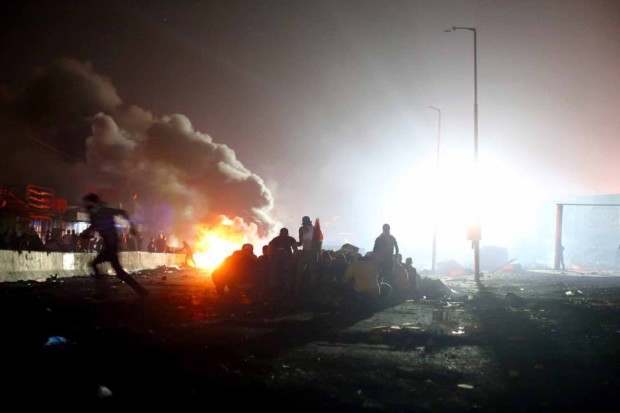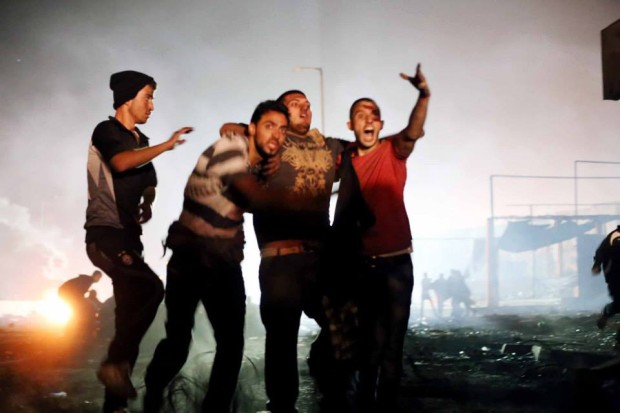
Image by Khaled Jarrar, of Palestinian youth during a a civilian protest for Gaza at the Qalandia military checkpoint. According to Jarrar’s Facebook page, the protest “was attacked by the Israeli army by live ammunition and rubber coated bullets”. Jarrar was at the protest last Thursday, during his opening at Whitebox Art Center
I saw a lot of exasperated faces last week outside of Undercurrent Projects, an hour or so into the opening for the Palestinian solidarity art workshop “10 Days/10 Ideas”. Conceived of by Palestinian artist Khaled Jarrar, and a small team, the workshop was intended an unaffiliated satellite exhibition to Jarrar’s current show “No Exit” at Whitebox Art Center; the show documents violence in the Gaza Strip, and the title references Jarrar’s own inability to leave the country after Israeli border control denied him the right to travel. Jarrar’s predicament seemed all too fitting, since Jarrar documents Palestinian people’s often dangerous struggles to cross borders– namely in his 2012 documentary “Infiltrators”, which is currently on view at the New Museum. Instead, Whitebox Art Center opened their show by livestreaming Jarrar from a protest in Ramallah.
The following workshop– whose title referenced Hamas’s ten conditions put forward for a ceasefire between Israel and Palestine– was supposed to show video art, as well as hold nightly workshops for creative people to consider solutions to the problems identified in Jarrar’s work. But once attendees moved on to Undercurrent Projects, they were again shuttled elsewhere when the event was unceremoniously cancelled. Apparently, there were issues with the workshops’ direct political intent. (Hyperallergic’s Hrag Vartanian covered the evening in full). After a sobering ten minutes, visitors finally landed at a bar, where curator Myriam Vanneschi explained that there had been a disputes over the show’s original title, “10 Days/10 Demands”, because the venue had felt that the intention veered out of the realm of art and into direct political action. (More details, from Ben Davis on Artnet News). “Jarrar has signed the entire exhibition as one artwork,” organizer Rhett Jones told me later via email. “In this case the blank pages that should have contained ideas, remain pointedly blank.”
At the bar, Khaled Jarrar’s friend Amin Husain– Jarrar’s spokesperson for the evening– then began describing Jarrar’s interactions with border control, before being cut off by the bartender, who asked him to stop his “oratory.”
It was a weird night. I called Husain for more details; he sounded a little worn out, but composed. Husain is a Palestinian-American lawyer and activist, and an editor of the OWS weekly, Tidal Magazine. He’s also a member of MTL, an artist collective which works on direct action campaigns like those for migrant worker rights on Saadiyat Island, and has authored several Creative Time Reports on Palestine, Hurricane Sandy, and Strike Debt.
Whitney Kimball: At the bar, you had told a moving story about Khaled’s interaction with border control. Would you mind telling me again?
Amin Husain: Well, I’d been talking about the how travel restrictions on the Palestinians and the lack of freedom of movement is a major problem; what happened to Khaled is not uncommon. But keep in mind that Khaled, as an artist, is a lot more privileged, than, for example, other people in the West Bank, and those under siege in Gaza.
Khaled had actually got a visa and reached Allenby Bridge, but once he arrived, he was held by the Israeli intelligence officers for hours. I think it’s a form of dehumanization, as he described it, that they don’t even pay attention to your existence.
Anyhow, in this time that he spent waiting, he began laying his papers on the ground to make various shapes. The soldiers actually perceived this as a transgressive act; one of the soldiers came up to him and asked, ‘What are you doing?’, and Jarrar replied ‘That’s not an important question.’
And the soldier kept pressing him, and Khaled said ‘No, you won’t understand what I’m doing. The better question is Why am I still here, why are you not letting me travel?’
And the soldier asked ‘Just tell me, what are you doing?’
He said, basically, ‘This is abstract art.’
And the soldier was like, ‘What’s abstract art?’
In a way, that was Khaled’s usage of art to kind of assert the presence, and gain some control over his situation, that I thought was really powerful. What I was mentioning that night was, that’s a power of art, especially as it relates to Khaled’s practice of interrogating borders and questioning boundaries, and the like.
WK: Have you heard from him since, or recently?

Image from Khaled Jarrar on Facebook. His caption: “Palestinian youth carrying an injured young man, who was injured in his knee by live ammunition shot by Israeli sniper during a civilian protest for Gaza.”
AH: On Facebook, we’ve kept in touch. He’s doing fine. I think he’s taking pictures right now of what’s going on. Things are pretty intense. I think that this travel ban is only for a month. He mentioned it’s a bit humiliating. ‘If I had a travel ban that was indefinite, that would make sense, but it’s a travel ban just to miss the show.’
WK: What were some of the ideas that you would have hoped to discuss in the “10 Days/10 Ideas” workshop?
AH: I think for me, as the person who would be involved in putting together the ad hoc direct action, the idea was…that it wouldn’t just be conversation, it would be conversation that would lead to action in the city. It’s part of what people have been doing since Occupy. A friend of mine, Yates McKee, is about to publish an article about art after Occupy, and it’s really important observation about where we’re at. The idea of art as being part and parcel of a broader movement…could take you all the way back to surrealism. So that was a space for us to tackle what’s happening and to bring people together to think creatively, but not just in an abstract sense.
That the “10 Days” came from Hamas’s call for ceasefire, which includes the removal of the eight-year siege, the increase of the area of water where the fishermen can fish. You can imagine a lot of ideas for action in New York City would emanate from that. But that was part of what got rejected, I think, in the naming of it by the NGO.
WK: So where do you see a line between art and political action? Do you think there is one?
AH: This is what I think everyone is struggling with. I don’t know Khaled’s opinion, but for me, being based in New York, and having been deeply involved with Occupy, the question isn’t What’s the line between art and activism, or art and organizing? The question is more, How do we live?
In my collective, MTL, we’ve been successful at working both inside and outside of the art world, and we’re always asking ourselves What’s worth doing? We know the power of art, and we don’t want to diminish aesthetics. But we also know that’s not the end all, be all, and it’s part of a moment and a movement that people are still trying to understand and define. Along with aesthetics, research and organizing are necessary.
WK: What do you think is the next step for the workshop? Have those conversations gone elsewhere?
AH: Frankly, I’m not entirely sure what’s been decided about that. The question is, really, is it about the workshops, now, or is it about what just happened? Do we look for another space to do art and activism, or should we make [the lack of space to do so] be our art and our activism?
This is the critique I gave Nato Thompson, when Creative Time let their “Living as Form” show travel to the Israel’s Technion, a major producer of militarized drones. [The Technion] is now in partnership with Cornell, working out of Google offices, about to [open a new campus] in Roosevelt Island here in New York City.
What we had told [Creative Time] was, Look: you’re talking about presenting dialogues about these things, and yet the thing that you’re doing is actually promoting the bad thing that you’re having a dialogue on. This is the tension after Occupy. Can people take this position of I’m not implicated, I’m doing stuff that’s important for this external thing, when their reflection of the reality is way off?
As a community coming together around art and cultural production, we must come together and have these difficult conversations and find ways to support each other. The only way that we’re going to be able to resist and open up these spaces in the art world is if we actually give each other that space to do it. We all have lives, we all have to do the best that we can, and no one is in our shoes. But we must also be honest with ourselves.
But with Creative Time, it was much easier [to criticize], because that’s the example, probably, of what’s wrong: you can’t benefit from putting up the banner of social justice, taking up the space around inequality, taking up all these issues, while, in a way, simultaneously furthering inequality, gentrification, and normalizing the occupation of Palestine. There are institutions which actually do just benefit from the status quo.
And then there’s the other thing, which I think is really important: what is the responsibility of each of us, in the context of potential genocide? Or in the context of ethnic cleansing? This is an important question because sometimes dialogue is not action to be taken.


Comments on this entry are closed.